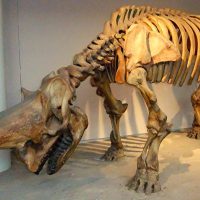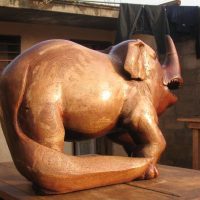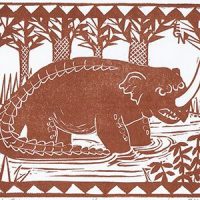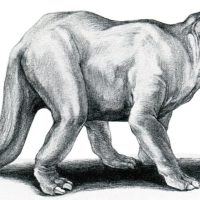Emela Ntouka : The Legendary Elephant Killer of Central Africa
Listen
At a glance
| Description | |
|---|---|
| Origin | Mbuti & Twa Mythology |
| Classification | Animals |
| Family Members | N/A |
| Region | Democratic Republic of the Congo |
| Associated With | Size, Ferocity |
Emela Ntouka
Introduction
Emela Ntouka occupies a fascinating place in the mythological landscape of Central Africa, particularly within the oral traditions of the Mbuti and Twa communities who have lived in harmony with the Congo Basin for generations. This mysterious creature is often depicted as a massive, semi-aquatic beast lurking in the region’s deep swamps and river systems. Its Lingala name, meaning “killer of elephants,” immediately conveys its fearsome status in local folklore, where it is remembered as an animal capable of defeating even the most powerful forest giants.
For the Mbuti and Twa, the forest is not merely a place of survival, but a sacred and living spirit-realm where every creature carries significance. Emela Ntouka reflects this worldview. It embodies the boundaries between the known and the unknowable, the seen and the spiritual. While some contemporary researchers have tried to link the creature to undiscovered megafauna or prehistoric survivors such as ceratopsian-like animals, these interpretations remain speculative. What persists, however, is the creature’s deep cultural resonance and the lasting curiosity it stirs among anthropologists, folklorists, and cryptozoologists.
Physical Traits
Accounts of Emela Ntouka describe a creature of massive proportions, said to rival the size of an African elephant. Its appearance is dominated by a large, single horn positioned on its snout—sharper and more elongated than that of a rhinoceros, and believed to be the source of its ability to pierce the toughest hides. The hide itself is typically described as thick, smooth, and brownish-gray, resilient enough to withstand the harsh wetlands it inhabits.
The animal’s body is built for strength and endurance. Its legs are stocky and powerful, designed to support an immense weight both on land and in shallow water. Many narratives describe a strong, muscular tail, sometimes said to resemble that of a crocodile, suggesting an adaptation to a life spent partly submerged. Locals consistently portray the Emela Ntouka as a semi-aquatic grazer feeding on water plants—particularly Malombo vegetation—using prehensile lips to pull reeds and leaves from riverbeds. Some traditions also attribute deep grumbling calls or growls to the animal, reinforcing its image as a dominant and territorial presence within the forest’s waterways.
Family
Unlike the genealogies assigned to gods or ancestral spirits, beings like Emela Ntouka exist within the Mbuti and Twa belief system as part of the forest’s spiritual ecosystem rather than as members of a defined family. Animal figures in these traditions often share the same life-force as humans and spirits, forming an interconnected community of beings that shape the forest’s identity. In this way, Emela Ntouka is viewed less as an isolated monster and more as a manifestation of the forest’s will.
Though no direct mythic relatives are assigned to the creature, it is sometimes discussed alongside other Central African cryptid-like beings such as Mokele-Mbembe. These comparisons arise not from shared bloodlines but from shared symbolism—both represent impenetrable wilderness and the dangers hidden in remote environments. In narratives told near rivers and swamps, Emela Ntouka is often portrayed as a solitary animal, fiercely territorial and rarely seen, emerging only to defend its domain or seek mates during brief encounters.
Other names
Across Central Africa, the legend of Emela Ntouka shifts slightly depending on the region, reflected in the many names associated with it. Communities living along the Congo Basin refer to the creature using terms such as Aseka-moke, Njago-gunda, Ngamba-namae, Chipekwe, N’Goubou, and Irizima. Each name arises from a unique linguistic tradition yet points to a similar creature—large, horned, and powerful enough to challenge the greatest animals of the forest.
These variations illustrate how widespread the core narrative has become. They suggest a creature whose reputation travelled between tribes over generations, embedding itself deeply into cultural memory and shaping collective interpretations of the dangers hidden within the waterways.
Powers and Abilities
The abilities attributed to Emela Ntouka stem mainly from its immense physicality rather than supernatural traits. Its signature power is the strength and lethality of its horn, believed capable of killing elephants—a role that has secured its title as one of the forest’s most feared animals. Tales describe it charging intruders, overturning canoes, and confronting even buffalo or hippopotamuses when threatened.
Its adaptation to both land and water contributes to its elusive reputation. Locals insist the creature moves silently through rivers, using its heavy tail for propulsion and its muscular frame to navigate dense vegetation. Although vegetarian, it is known for its aggression, particularly when defending territory. Its deep vocalisations, described as rumbling growls, reinforce its dominance over the swamp regions.
Symbolically, Emela Ntouka’s abilities represent the forest’s strength and capacity to defend itself. It stands as a warning to those who disrespect nature’s boundaries, embodying the belief that the wilderness holds guardians invisible to those lacking cultural knowledge.
Modern Day Influence
In recent decades, Emela Ntouka has moved beyond traditional folklore to become a recurring figure in cryptozoological discussions. Western explorers and researchers in the mid-20th century documented accounts from local communities, sparking debates about whether the creature could be a remnant population of ancient megafauna. While no scientific evidence supports this theory, the idea continues to fascinate enthusiasts of unexplained natural phenomena.
The legend has since entered books, documentaries, online forums, and speculative biology studies that explore the possibility of undiscovered species in remote areas. Artists often depict the creature as a prehistoric-looking beast, blending rhinoceros-like features with dinosaurian traits inspired by local descriptions.
For the Mbuti and Twa, however, Emela Ntouka has not lost its cultural significance. It remains a potent symbol of the forest’s mystery and power—an entity that commands respect, deepens spiritual understanding, and reminds people of the delicate balance between human presence and the wild.
Related Images
Source
Blancou, L. (1954). The Emela-Ntouka and its behavior. Mammalia Journal.
Monstropedia. (2003). Emela-ntouka. Retrieved from https://www.monstropedia.org/index.php?title=Emela-ntouka
Study.com. (2017). African Mythical Creatures. Retrieved from https://study.com/academy/lesson/african-mythological-creatures.html
Monster Fuzz Podcast. (2021). Emela-ntouka, A Dinosaur in The Congo. Retrieved from https://monsterfuzzpodcast.com/2021/06/18/emela-ntouka-a-dinosaur-in-the-congo/
Genesis Park. (2025). The Emela-ntouka of the Congo. Retrieved from https://genesispark.com/exhibits/cryptozoological-evidence/the-ceratopsian-enclave/the-emela-ntouka-of-the-congo/
Reality Send. (2024). Emela Ntouka. Retrieved from http://www.realitysend.com/bd/bestiary/emelantouka
Non-Alien Creatures Wiki. (2007). Emela-ntouka. Retrieved from https://non-aliencreatures.fandom.com/wiki/Emela-ntouka
Heuvelmans, B. (1995). On the Track of Unknown Animals. London: Kegan Paul International.
Mackal, R. (1987). Searching for Hidden Animals: An Inquiry into Zoological Mysteries. Garden City, NY: Doubleday.
Shuker, K. (1997). The Unexplained: An Illustrated Guide to the World’s Paranormal Mysteries. Carlton Books.
Forth, G. (2004). Mythical Creatures: Anthropological Perspectives. Routledge.
Guiley, R. E. (2009). The Encyclopedia of Demons and Demonology. Facts on File.
Frequently Asked Questions
What is Emela Ntouka in African mythology?
Emela Ntouka is a legendary horned creature from Mbuti and Twa folklore, believed to inhabit the swamps and rivers of the Congo Basin.
Why is Emela Ntouka called the “killer of elephants”?
The creature is said to possess a powerful single horn capable of piercing even elephant hide, giving rise to its fearsome title.
Is Emela Ntouka considered a dinosaur or real animal?
Some cryptozoologists speculate about prehistoric connections, but there is no scientific evidence supporting its existence as a real species.
Where is Emela Ntouka believed to live?
It is traditionally associated with the Congo Basin’s wetlands, particularly deep swamps and river systems.
How does Emela Ntouka influence modern culture?
It appears in cryptid studies, documentaries, speculative biology, and discussions about African folklore and unexplained creatures.









